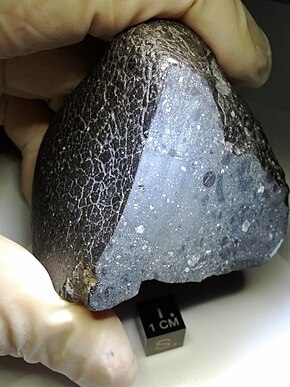| Northwest Africa 7034 | |
|---|---|
 Northwest Africa 7034, nicknamed "Black Beauty" | |
| Type | Achondrite |
| Clan | Martian meteorite |
| Grouplet | Martian (basaltic breccia)[1] |
| Composition | Plagioclase and pyroxene phenocrysts in a fine groundmass.[2] |
| Weathering grade | Minimal[1] |
| Country | Western Sahara, Morocco |
| Coordinates | 24°5.311′N 14°46.671′W / 24.088517°N 14.777850°W[3] (purchased from dealer)[1] |
| Observed fall | No |
| Found date | 2011 |
| TKW | 320 grams (11 oz)[1] |
Northwest Africa 7034 is a Martian meteorite believed to be the second oldest yet discovered.[4] It is estimated to be 4.43 billion years old and contains the most water of any Martian meteorite found on Earth.[5] Although it is from Mars it does not fit into any of the three SNC meteorite categories, and forms a new Martian meteorite group named "Martian (basaltic breccia)".[1] Nicknamed "Black Beauty", it was purchased in Morocco and a slice of it was donated to the University of New Mexico by its American owner.[1] The image (shown on the right) of the original NWA 7034 was photographed in 2012 by Carl Agee, University of New Mexico.
- ^ a b c d e f "NWA 7034". Meteoritical Society. Retrieved 4 January 2013.
- ^ Cite error: The named reference
Agee 2012 Conferencewas invoked but never defined (see the help page). - ^ Cite error: The named reference
auto1was invoked but never defined (see the help page). - ^ Associated Press (January 4, 2013). Mars meteorite 'Black Beauty' contains most water of any found on Earth, say scientists. The Guardian
- ^ Lagain, A.; Bouley, S.; Zanda, B.; Miljković, K.; Rajšić, A.; Baratoux, D.; Payré, V.; Doucet, L. S.; Timms, N. E.; Hewins, R.; Benedix, G. K.; Malarewic, V.; Servis, K.; Bland, P. A. (2022-07-12). "Early crustal processes revealed by the ejection site of the oldest martian meteorite". Nature Communications. 13 (1): 3782. doi:10.1038/s41467-022-31444-8. ISSN 2041-1723. PMC 9276826.